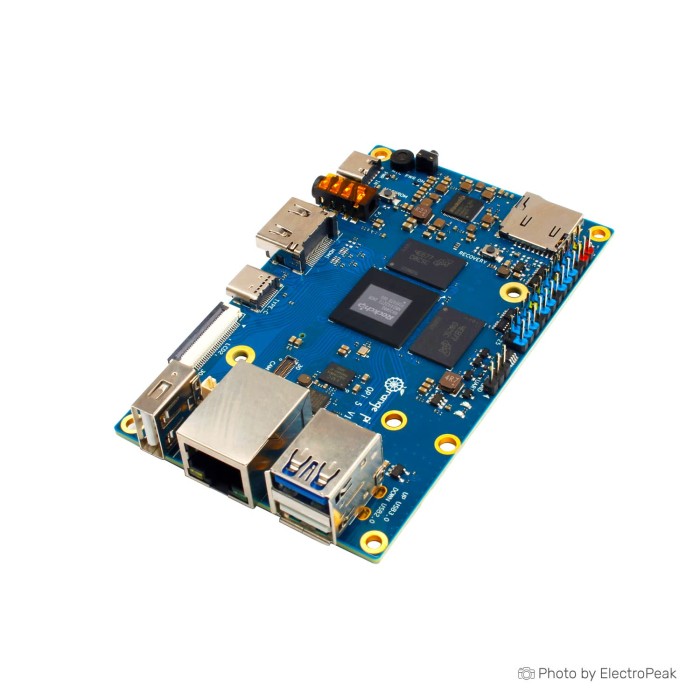The Orange Pi 5 features a powerful SoC, generous RAM (up to 32GB), USB 3.0 ports, Gigabit Ethernet, and support for 8K video playback, distinguishing it in terms of performance and connectivity.
Orange Pi 5 Development Board - 4GB RAM
Volume discounts:
- +5 1 % $97.4600
- +10 1 % $97.0100
- +25 2 % $96.5600
- +50 2 % $96.1100
- +100 3 % $95.6700
 Orange Pi Lite 2 Development Board
Previous
Orange Pi Lite 2 Development Board
Previous

The Orange Pi is a series of single-board computers (SBCs) produced by the Chinese company Shenzhen Xunlong Software. These devices are designed for various applications and projects, similar to other popular single-board computers like the Raspberry Pi. Orange Pi boards typically feature a system-on-a-chip (SoC) with integrated CPU, GPU, RAM, and other components, making them capable of running various operating systems and handling a range of tasks.
Orange Pi 5 uses Rockchip new generation 8-core 64-bit processor with 8nm process design, integrated GPU, with 32GB LPDDR4X, and up to 8K display processing capability.
It supports Orange Pi OS (Droid), the official operating system developed by Orange Pi, as well as Android12, Ubuntu, and Debian11.
Specifications of Orange Pi 5 - 4G RAM:
- SoC: Rockchip RK3588S (8nm LP process)
- CPU:8-core 64-bit processor
- Big.Little Architecture: 4xCortex-A76 and 4xCortex-A55,
- Big core cluster is 2.4GHz, and Little core cluster is 1.8GHz frequency.
- GPU: Arm Mali-G610 MP4 "Odin" GPU
- Compatible with OpenGL ES1.1/2.0/3.2, OpenCL 2.2 and Vulkan 1.2
- 3D graphics engine and 2D graphics engine
- NPU: Built-in Al accelerator NPU with up to 6 TOPS, supports INT4/INT8/INT16 mixed operation
- PMU: RK806-1
- RAM: 4GB/8GB/16GB/32GB (LPDDR4/4x)
- Memory: QSPI Nor FLASH 16MB
- MicroSD (TF) Card Slot
- M.2 M-KEY Socket
- USB: USB3.0 x 1
- USB2.0 x 2
- Type-C (USB3.0) x1
- Video Output: HDMI2.1, up to 8K @60Hz
- DP1.4 (DisplayPort), DP1.4 and USB3.1 ports are multiplexed, and the port is shared with Type-C
- 2 * MIPI D-PHY TX 4Lane, configurable up to 4K @60Hz
- Camera: MIPI CSI 4Lane
- 2 * MIPI D-PHY RX 4Lane
- Audio: CODEC: ES8388
- 3.5mm headphone jack audio input/output
- Input: Onboard MIC
- HDMI 2.1 eARC
- Ethernet: 10/100/1000Mbps Ethernet
- Expansion Port: For extending UART, PWM, I2C, SPI, CAN and GPIO interfaces.
- M.2 M-KEY Socket Expansion
- Slot: Support PCIe NVMe SS Support custom PCIe Wi-Fi6+BT5.0 module
- Button: 1xMaskROM key
- 1xRecovery key
- 1xOn/off key
- Power Source: Support Type-C power supply, 5V @ 4A
- LED: Power indicator: red
- Status indicator: green
- Debugging: 3 Pin debug serial port (UART)
- Supported OS: Orangepi OS (Droid) , Orangepi OS (Arch) , Ubuntu, Debian, Android12
- Dimension: 62mm*100mm
- Weight: 46g
What are the key features that set the Orange Pi 5 apart from other single-board computers?
How does the Orange Pi 5 compare to the Raspberry Pi 4 in terms of performance?
According to benchmark tests, the processing power of Orange Pi 5 is twice that of Raspberry Pi 4.
Orange Pie is able to output the image with 8k resolution, which is 4 times that of Raspberry Pi 4 with 4k resolution.
In terms of connection options, the only difference between the two is that the Orange Pie has a USB type c 3.1 port that can also be used as a display port (DP) 1.4.
Orange Pie also has a pcie version 2 port that you can connect Wifi 6+Bluetooth 5.0 module or add an NVMe memory to your board.
What operating systems are officially supported on the Orange Pi 5?
A: The Orange Pi 5 supports various operating systems, including Orange Pi OS (Droid), Ubuntu, Debian, and Android. Additionally, community-supported OS options may be available to suit different project needs.
How is the development community and support for the Orange Pi 5?
A: The Orange Pi 5 has an active community with forums and online resources. Official documentation, forums, and community-driven support channels are available for troubleshooting and project discussions.
What are the power requirements for the Orange Pi 5?
The Orange Pi 5 typically requires a 5V/3A power supply. It's important to use a stable power source to ensure optimal performance.
What accessories do we need for the initial setup of Orange Pi 5?
Setting up an Orange Pi 5 will require a few essential accessories. Here's a list of items you'll need for the initial setup:
Power Supply: A USB-C power supply, typically 5V/3A, suitable for powering the Orange Pi 5. This 5V/4A AC adapter is suitable for use.
MicroSD Card: A microSD card for storing the operating system and other data. Ensure it has enough capacity (at least 8GB recommended) and is compatible with the Orange Pi 5. You can use this 16gb class 10 micro sd card.
Display and HDMI Cable: A display device such as a monitor or TV with an HDMI input. You'll also need an HDMI cable to connect the Orange Pi 5 to the display.
Keyboard and Mouse: A USB or wireless keyboard and mouse for interacting with the Orange Pi 5 during the setup process.
Network Connection: An Ethernet cable for a wired connection to your network. Alternatively, you can use the Orange Pi 5's Wi-Fi module, so a compatible Wi-Fi network is also an option.
Case (Optional): While not essential, a case can help protect the Orange Pi 5 and provide a neat and organized setup. Make sure the case is compatible with the Orange Pi 5 model. For example, this Aluminum Case for Orange Pi 5/5B with Fan Active Passive Cooler with Heatsink Black Metal Shell has cooling fan included, that guarantees long-term trouble-free operation.
MicroSD Card Reader: microSD card reader for connecting the microSD card to your computer for flashing the operating system image. For example, you can use this type of ultra small micro sd card reader.
Additional Peripherals (Optional): Depending on your project, you may need additional peripherals such as sensors, cameras, or other hardware components. Make sure they are compatible with the Orange Pi 5 and have the necessary connectors.
Always refer to the official Orange Pi documentation and community resources for the most accurate and up-to-date information on setting up your specific model of Orange Pi.





Please complete your information below to login.
Sign In
Create New Account